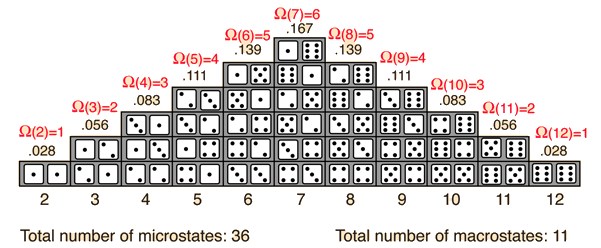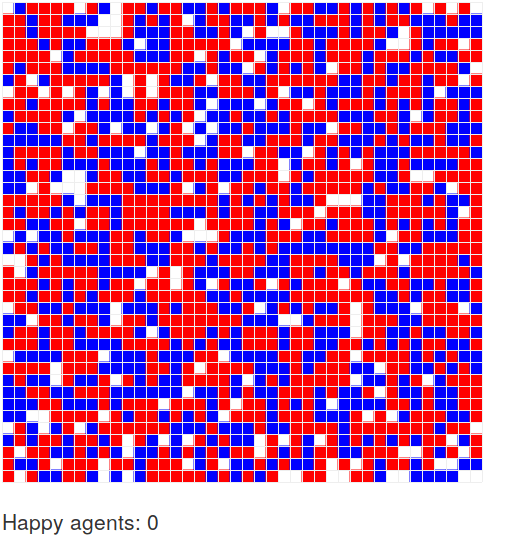Cities and the contemporary society: some thoughts from the complexity sciences
- 20 minsThis is my translation of the article that I published in the science section of my local newspaper "Fet a Sant Feliu" the 12 of January of 2019
I have always found certain sadness underlying the second principle of thermodynamics. The first time that I learned about it was to know that it impedes us of building perpetual motion machines. Subsequently, high-school courses on physics and chemistry teach us how it is strongly tied to the notion of irreversibility. Formally, the second principle of thermodynamics establishes that the entropy of a closed system can only increase, and thus never decrease. But what is entropy?
The fact that we tend to associate entropy with disorder can be largely attributed to the legacy of Ludwig Boltzmann, the father of statistical mechanics. His interpretation of entropy can be clarified through the following example. Let’s consider we roll two dices. The image below illustrates all the 36 possible resulting configurations (microstates), grouped in columns according to the sum of the dices’ values (macrostates).

According to Boltzmann, the macrostate of maximum entropy is the one with most possible microstates. In our two-dice system, such macrostate corresponds to when the dices’ values add up to seven, given that there are six possible results that can bring us to such configuration. Instead, the two lateral ends of the image, that is, the macrostates where the dices’ values add up to two or twelve, correspond to the macrostates of minimal entropy, given that there is only one possible microstate (where we roll two ones or two sixes respectively).
Boltzmann was convinced that the macroscopic behavior of gases could be explained through the configurations formed by their molecules, quantifiable by such measure of entropy. Unfortunately, in a historical context where most of the scientific community did not believe in the existence of atoms, his contributions conflicted with many of his peers. In fact, apropos of the sadness of the second principle of thermodynamics mentioned above, it is worth pointing out that the constant criticisms on his work together with other personal circumstances lead Boltzmann to commit suicide during a family vacation in Trieste in 1906, just before the atoms became the zeitgeist of science during the twentieth century.
The idea that when we repeatedly throw two dices, the most recurring result will be a a combination where the values add up to seven is consistent with the second principle of thermodynamics in that closed systems tend to its configurations of maximum entropy. Nevertheless, this is not the behavior displayed by many of the systems that we encounter in nature or the contemporary society.
An interesting example is the behavior observed in ant colonies. The image below (and in more detail in this video) highlights that there exists strong collective order behind the movement of ant colonies.

From Boltzmann’s perspective, among all possible configurations, ant colonies tend to strongly ordered patterns, with very low entropy, and thus their occurrence should be very unlikely. Yet this is what we encounter.
Unlike with dices, the interactions between ants are not random, since they pursue collective objectives of locating and storing food. However, it remains surprising that, as suggested by a long line of investigations1, the collective order observed in ant colonies emerges from local interactions within neighboring ants, with practically no global communication.
As one might imagine, ant colonies are not the only system which, in apparent defiance of the second principle of thermodynamics, tends to generate ordered patterns. In fact, concurrent to the advances on the understanding of the behavior of ant colonies2, the Nobel laureate in Chemistry Ilya Prigogine suggested that the reason why certain systems do not evolve towards states of maximum entropy is that the second principle of thermodynamics as well as Boltzmann’s probabilistic interpretation of entropy only apply to closed systems, that is, systems that do not interact with their environment.
There exists thus, a class of systems which Prigogine called ‘dissipative’, which as result of certain interactions with their environment, evolve towards ordered configurations3. It seems reasonable to consider that cities - the subject of study of my PhD thesis - are part of this class of systems. A nice illustration of this kind of behavior that is applicable to contemporary cities is Schelling’s segregation model4. Let’s consider a city with two kinds of inhabitants, the reds and the blues. As far as this example is concerned, the city will be represented by a grid of 40x40 cells, where 50% of them will be occupied by reds, 40% by blues and 10% empty. The central idea is very simple. Each inhabitant will consider his or her cell-location satisfactory if and only if at least four out of their eight neighbors are of the same color. In the opposite case, they will try to relocate to another cell. Starting from a random configuration, this mechanism will be applied until all agents are satisfied. The evolution of the city is illustrated below5:

It is easy to see that in our city, analogously to ant colonies, a global order emerges from interactions that consider only local criteria. In the terminology of complex systems, these phenomena are said to exhibit emergent properties, which have not been directly incorporated within the design of the system but they have been an indirect result of their functioning - through a process of self-organization.
While Schelling’s model might be excessively simple and restricted to pedagogical purposes, contemporary cities also exhibit clear characteristics of self-organization and emerging order. A noteworthy example is the urban sprawl that we can observe in many Western cities, with Los Angeles, Atlanta or Houston as archetypal examples. The term urban sprawl has often been associated to pejorative connotations of disorganization and lack of planning.

Nonetheless, the commuting behavior of such sprawling cities reveal that, behind their haphazard visual impression, there is strong order underpinning their spatial development: despite notable suburban expansion of the largest metropolitan areas of the United States during the 80s and 90s, the commuting times have remained stable6. At the same time, the number of commuting trips with both origin and destination in the suburbs increased substantially, which suggests that residences and businesses mutually co-locate7. Therefore, while it is fair to consider that urban sprawl misuses space and induce automobile dependency, it is by no means a disordered phenomena. It is rather the result of a complex series of interactions mediated by many factors such as residential preferences, land value, existing infrastructure and the like.
To what extent systems that display self-organization and emerging properties are considered purely mechanical or some sort of animate organism is one of the fundamental questions of the last centuries of Western science and philosophy8. In any case, the way in which the interactions between inhabitants can generate an emerging order without the intervention of any planning agent is a clear defiance of “planning” as a rational activity. This does not mean that any attempt to planning is futile but rather that most of the urban planning movements developed throughout the latest two centuries are not adequate for the kind of problems that contemporary cities pose. This is in fact the fundamental criticism of the journalist Jane Jacobs in her seminal book “The Death and Life of Great American Cities”, where she wrote:
Merely to think about cities and get somewhere, one of the main things to know is what kind of problem cities pose . . . .
Cities happen to be problems in organized complexity, like the life sciences. They present “situations in which a half-dozen or even several dozen quantities are all varying simultaneously and in subtly interconnected ways . . . . The variables are many but they are not helter-skelter; they are “interrelated in to an organic whole.” . . . .
The theorists of conventional modern city planning have consistently mistaken cities as problems of simplicity. . . and have tried to analyze and treat them thus9
Similarly, and referring to the critique that the Marxist geographer and anthropologist David Harvey addresses to the models of classic urban economics, the also geographer Juval Portugali wrote the following:
[your models are] “incapable of saying anything of depth and profoundity . . .”; not because you are bad guys or second-rate professionals, but because like Don Quixote, you tilt at windmills, and by doing so not only do you not harm the real beast - the Capitalist mode of production - but you actually participate in its reproduction; not only that your sophisticated plans do not reduce injustice in the city, but they reproduce it; create it anew again and again. Capitalism with its city of injustice is advancing and flourishing behind the ideological false consciousness of your liberal science and planning[^portugali-harvey]
Regardless of what one might think of capitalism, the emergent properties of complex systems such as cities and society in general, for instance the distribution of wealth or social mobility, are the result of the numerous interactions between the agents that constitute it, inevitably guided by certain economic, social and political system (whether it is capitalism, socialism or another). In fact, the notion of emergent properties resulting from a process of self-organization is salient on the “invisible hand” principle of Adam Smith, and liberal economists such as Friederich Hayek have actually built upon them to defend capitalism, considering the free market as the only mechanism capable of taking advantage of the dispersed knowledge present in our society.
In any case, it seems increasingly clear that conventional planning tools such as master plans are not enough to overthrow the emerging order that emanates from the actions and decisions of citizens in the context of capitalism, increasingly influenced by the globalization, volatility of the job market, technological advances and the incursion of platforms such as Airbnb and Uber[^planning-failures].
Last summer I visited the Pueblos Mancomunados de la Sierra Norte de Oaxaca, in Mexico. It is a group of eight villages that conform a cooperative and community organization since pre-colonial times, which were formally constituted as an agrarian entity in 1961[^pueblos-mancomunados]. Their economic activities consist basically of agriculture, sustainable logging, and since 1995, a communal ecotourism program.

One of the days, a local guide took us to the ‘Amanecer’ lookout to see the sunrise, and I took the opportunity to ask some questions about the organization of the communities. He explained us that any person, regardless of his or her nationality, can move there - provided that he or she agrees to follow the community rules. Each family is entitled to cut three pines in order to build their house, expansible for large families. Their local economy offers a series of jobs, however nobody is bound to take any specific job. The main duty as a citizen are the “cargos”, which consist of some basic tasks for the functioning of the communities, such as logging, organization of citizen and school boards, or jobs derived from the ecotourism program, among others. Every for years, a member of each house, aged between 18 and 65, must perform the “cargos” during a whole year as an unremunerated service to the community. On the other hand, it is worth pointing out that all the profits from the ecotourism program, which does not come cheap considering Oaxacan and Mexican prices, are entirely devoted to community projects. Altogether, not only their community system yields a fairly egalitarian distribution of wealth (which is relatively unsurprising), but also their local economy seems to enjoy good health.
At this point, it is easy to argue that under the functioning mode of the Pueblos Mancomunados, humanity would have never discovered subatomic particles, penicillin nor the field-effect transistor. I will not proceed into the evaluation of such remarks, since I do not intend to showcase the Pueblos Mancomunados as the universal model of an ideal society. The final reflection that I would like to raise is another. There is a perception, quite spread among our society, that the government positions are bound for people with high-level university education, since it is only with such background that one might be prepared for the arduous task of governing a system as complex as our society.
Nonetheless, it seems that such perception does not prevail so much for local governments, where other less-technical skills are more valued. Regarding this, I will conclude with an excerpt from Hayek, which leaving aside what one might think of his ideology, I find very pertinent to this discussion:
There is . . . a body of very important but unorganized knowledge which cannot possibly be called scientific . . . : the knowledge of the particular circumstances of time and place. It is with respect to this that practically every individual has some advantage over all others because he possesses unique information of which beneficial use might be made, but of which use can be made only if the decisions depending on it are left to him or are made with his active cooperation . . . Central planning based on statistical information by its nature cannot take direct account of these circumstances of time and place[^hayek-moroni]
I hope that I have illustrated how in complex systems such as cities and the contemporary society, interventions do not always achieve the action-reaction effect that one might expect, not even when planned by experts with high academic qualifications. Therefore, I would like to raise a question concerning whether such interventions should be preferably managed by local governments, and by people that - no matter their academic training - know the particular circumstances of time and place of each neighborhood, village or city[^oaxaca-timezone], and to whom we can direct our concerns without the need to talk to three secretaries nor booking a flight to Madrid or Brussels. Although a network of local governments taking decisions that likely overlap between one city and another might seem inefficient when compared to a sole centralized government, according to Prigogine’s theory, it is in fact such dispersed knowledge and distribution of actions that allows complex systems to adapt to the changing circumstances of the world that surrounds us.
Notes
-
See J. L. Deneubourg et al. “Probabilistic Behaviour in Ants: A Strategy of Errors?” (1983). ↩
-
As a matter of fact, the connections between the contributions of Denenbourg and Prigogine’s teams are not a coincidence: their respective research groups were coexisted in the Université Libre de Bruxelles and carried out important academic exchanges. ↩
-
More precisely, ‘dissipative’ systems use their energy inputs to generate internal order while exporting their entropy to the environment.
Although Prigogine’s team developed the majority of their contributions within the context of thermodynamics, they realized very early that their discoveries were relevant for a broad group of scientific disciplines. This ambition is reflected in the title of one of their most influential works: “La Nouvelle Alliance. Métamorphose de la Science” (translated to English under the title “Order Out of Chaos: Man’s New Dialogue with Nature”). See I. Prigogine and I. Stengers “Order Out of Chaos: Man’s New Dialogue with Nature” (1984). ↩
-
The name of the model comes from the Nobel laureate in economy Thomas Schelling. ↩
-
The model’s parameters have been chosen according to computational criteria that make the animation more visually appealing. In any case, the model is deployed to https://schelling-mesa.herokuapp.com, allowing for further experimentation with its parameters (its performance is not the best since I used Heroku’s free tier). On the other hand, the source code is available in https://github.com/martibosch/mesa-schelling-example. ↩
-
Between 1980 and 1985, the commuting times of the largest 20 metropolitan areas of the United States remained practically constant, without significant differences for sprawling cities such as Los Angeles, Houston or Atlanta. See P. Gordon et al. “The Commuting Paradox: Evidence from the Top Twenty” (1991). Between 1990 and 2000, the commuting times have grown with an elasticity of 0.1 with respect to the number of workers; that is, for a 10% growth on the number of workers, commuting times have grown only by 1%. See A. Anas “Discovering the Efficiency of Urban Sprawl” (2011). ↩
-
See D. M. Levinson and A. Kumar “The Rational Locator: Why Travel Times Have Remained Stable” (1994). ↩
-
The French mathematician Pierre-Simon Laplace developed the deterministic notion that if somebody possessed the ability of knowing, with an infinite degree of precision, the positions and forces of all the elements that constitute the universe, the evolution of the universe could be determined with infinite precision by means of Newton’s laws of motion. Nevertheless, Laplace and the advocates of their deterministic thesis recognized that such abilities might only be attributed to a superhuman entity, which popularized the construction of “Laplace’s demon”. The vision that the evolution of any system might be fully determined by means of Newton’s laws, independently of the arduous workload involved, was shared by most physicists until the general acceptance of the principles of quantum physics during the decade of 1920. In fact, half a century before that, after empirically linking the macroscopic behavior of gases to the collective motion of their molecules, Boltzmann already suggested that the interactions between molecules might not be determined exclusively by Netwon’s laws. More precisely, Boltzmann suggested that the energy levels of molecules could be discrete. It was in fact such idea, subsequently developed by Max Planck, which lead to the departure from classical physics and the ensuing commencement of quantum physics. See K. Popper “The Open Universe: An Argument for Indeterminism” (1982) and I. Prigogine i I. Stengers “Order Out of Chaos: Man’s New Dialogue with Nature” (1984).
On the other hand, self-organization and emerging properties are central to the research on artificial life within the computational sciences. The father of digital computing Alan Turing introduced with his homonymous machine in 1936 the idea of a computer where memory served to store not only data but also code instructions. Following this principle, the Hungarian mathematician John von Neumann speculated with the concept of self-replicant machines, which through a particular set of instructions stored in their memory, could be able to reproduce their structure. This idea lead to a whole research field called Artificial Life, which focuses on the exploration - through computational simulation - of systems related to natural life. Remarkable results within this field suggest that there is only a very limited set of conditions under which systems that interact with variable environments (such as cities) might generate persisting structures. Such structures display fractal order, where parts of the structure share similar properties with the whole. Fractal structures are very ubiquitous within living systems and nature in general, as for instance tree branches, circulatory systems, snowflakes or the colors of some animals, but also within artificial systems such as cities, transportation networks or even in the frequency of financial transactions. See C. G. Langton “Studying Artificial Life with Cellular Automata” (1986), R. White and G. Engelen “Cellular Automata and Fractal Urban Form: A Cellular Modelling Approach to the Evolution of Urban Land-Use Patterns”, P. Frankhauser “La fractalité des structures urbaines” (1994), M. Batty and P. Longley “Fractal Cities: A Geometry of Form and Function”, and M. Batty et al. “Urban Systems as Cellular Automata” (1997). ↩
-
The excerpt is taken from the pages 431-435 of the book. The quotation marks are in reference to the essay that Warren Weaver wrote in the 1958 Annual Report of the Rockefeller Foundation, where he listed three stages in the development of scientific thought: (I) the ability of treating problems of simplicity - where two directly related variables are considered, such as the pressure of a gas and its volume - during the seventeenth, eighteenth and nineteenth century, culminating in the foundations of the theories of light, sound, heat and electricity; (II) the ability to address problems of disorganized complexity, tractable throughout the methods of statistical mechanics developed by Boltzmann and others, which allow us to statistically approximate the speed and number of collisions between molecules or billiard balls; and finally (III) the ability to address problems of organized complexity, where the complexity does not lie with the number of variables but with their interconnections, in a way that the behavior of the system cannot be approximated by studying its parts in isolation. See J. Jacobs “The Death and Life of Great American Cities” (1961). [^portugali-harvey]: The excerpt is taken from the page 34 of the book “Self-organization and the City” by Juval Portugali. The quotation marks are in reference to the book “Social Justice and the City”, by David Harvey. See D. Harvey “Social Justice and the City” (1973), and J. Portugali “Self-organization and the City” (1999). [^planning-failures]: There is a whole research line devoted to the conformance evaluation of master land use plans. In most cases, significant differences exists between the zoning regulations and the actual land use, mostly attributed to small local amendments required to accommodate circumstances that were not predicted in the land use plans. See N. Alfasi et al. “The actual impact of comprehensive land-use plans: Insights from high resolution observations” (2012), T. Zhong et al. “Success or failure: Evaluating the implementation of China’s National General Land Use Plan (1997–2010)” (2014) and P. Abrantes et al. “Compliance of land cover changes with municipal land use planning: Evidence from the Lisbon metropolitan region (1990–2007)” (2016). [^pueblos-mancomunados]: See https://www.gob.mx/conafor/prensa/pueblos-mancomunados-de-oaxaca-ejemplo-de-aprovechamiento-forestal-sostenible [^hayek-moroni]: The excerpt is taken from the pages 80-83 of the book “Individualism and Economic Order” by Friederich Hayek. See F. A. Hayek “Individualism and Economic Order” (1948) and S. Moroni “Rethinking the theory and practice of land-use regulation: Towards nomocracy” (2010). [^oaxaca-timezone]: An anecdotal yet interesting example of the self-management of the Pueblos Mancomunados is how, disregarding the Mexican central government, they do not apply any time change between summer and winter, given that their ancestors had never done so as there are no significant seasonal daylight differences in such latitude. ↩
